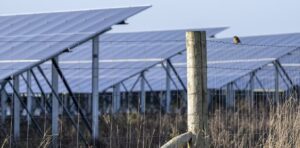One of the big questions that springs to mind when the likes of the International Energy Agency and other bodies deliver their stark warnings about climate change is whether the global energy industry is ready to respond to the challenge. If the IEA is right about its predictions, the energy industry will no longer have the luxury of a measured transition to a clean energy future, the change will be quick and dramatic.
So how is the energy industry positioned to respond? While in Paris, I met up with two senior executives from Alstom, the French energy giant that is one of the three big global suppliers of power equipment. By some measures, it ranks as the biggest, with interests in nuclear, coal, gas, hydro, and onshore wind, and more recently, in offshore wind, concentrated solar power, wave energy and tidal energy, and geothermal.
Loic Douillet, the vice president of marketing, and Philippe Paelinck, the vice president of portfolio and strategic planning, last week took RenewEconomy through a fascinating presentation of the global energy market, its sheer scale, and the direction they believe it is heading – both in size, technology source, and in energy market design.
To get some idea of the future, it is worth getting some idea of the present, and how we got there. Alstom shared some interesting graphs of the development of the electricity industry over the last 50 years.
This first graph below tells a couple of stories. The first is that the power industry has jumped from well below 50GW of installed capacity a year in 1960 to more than 350GW in some of the last few years.
The second is that the industry has been driven by waves of investment booms, and busts: the nuclear boom in the 1970s; the gas boom in the US a decade ago; the Chinese coal boom a few years later; and the global boom in emerging economies, revitalised western economies and in renewables just a few years ago.
(Please click on graphs if they are not completely visible in your browser).
The next graph introduces an interesting dimension. It shows the age of the plant that has been installed in the last 50 years. The oldest plant will be retired, but the middle section is where Alstom sees a massive market in retrofit – making plants more efficient, making them cleaner (removing mercury, for instance) and even adding carbon capture where possible.
One of the elements in the latest boom was the move to replace the ageing power plants – particularly in western Europe, north America, Australia and Japan. And of course, the growth in emerging markets such as China/India, the rest of Asia, the Middle East and Brazil. “They are doing what we were doing in the first wave, just a lot bigger,” Douillet says.
The next graph is interesting because it reflects some of the changing profiles of the various countries. The old “western economies” are showing a fall in demand – despite some modest growth in their economies. The biggest rise in demand is coming from those emerging nations, particularly the BRICs – Brazil, India and China. But Douillet and Paelinck make an important point – the rate of efficiency improvements in the power industry is doubling – and while the link between economic growth and power demand is not broken, it is steadily weakening.
The next graph shows where that investment is going. China is by the far the biggest market, but it is already committing at least 50 per cent of its investment in new capacity in zero-carbon technologies, and most of this in renewables. The same is true, to varying degrees, around the world.
This, Douillet says, is having a profound impact on the market. In many places (and Australia could be included here), too much capacity already exists, so the zero-carbon plants being installed are causing existing conventional plant to retire early. Turn back to graph number 2, and notice the spread at the bottom of the chart reflecting the addition of renewables. This, Alstom notes, is the game-changer for thermal plants.
That changing game, Douillet notes, will become a revolution when it comes to the way that energy markets are designed. As RenewEconomy pointed out in this article (Our Energy markets are broken), the energy markets based on the amount of energy produced are no longer functioning properly because of the impact of renewables.
As Douillet says, this is pushing thermal plant out of the system, even when some thermal capacity is required to balance that output (although he is careful to point out that a lot of new thermal capacity is not necessarily required for new renewables, because so much of it already exists. What is needed is flexible generation to meet those demands).
This, he says, means that “capacity” markets are not the answer either. As we noted in that article about energy markets, the ideal solution is a new form of market that some people call a “capabilities” market – Alstom likes to refer to it as a “flexibility” market: one that rewards the value of energy that is produced on demand.
In France, for instance, the regulator has made it mandatory for all power plants to operate at 5 per cent below capacity, meaning they can easily ramp up through control systems to respond to changing demand. It has built flexibility into the market.
But what about the IEA scenario, and the ability of the energy industry to meet the “450 scenario” which limits global emissions at 450 parts per million (probably too late because we are just about past that), and average global warming to 2°C?
Well, Alstom says that’s why they have accelerated their investment in solar thermal, ocean power, biomass and offshore wind – because such a scenario is likely. “You are a dead duck if you just invest in one technology,” Paelinck notes. They say many IPPs who have invested in baseload gas generation may never get a return on investment because of the changing demand and energy system profiles. Alstom has also invested heavily in CCS, but says this investment has been “stranded” by the lack of a strong carbon price in Europe.
Sadly, Alstom would not allow their internal estimates of the levellised cost of energy for various technologies to be published. Suffice it to say, it looks a lot like other estimates. Except for two things – one is that all technologies will need to gather around $100-$150/MWh – or at least to whatever is “grid parity” in their various locations – because all technologies will need to operate without special tariffs or subsidies in the future.
The second was that their estimate for large-scale solar – they are invested in solar tower technology which is being deployed in Israel – shows a significant discount for large-scale solar with storage than without – a discount of around 20-25 per cent. Many suggest that solar thermal is rendered more expensive by the addition of storage. That may be true for the capital cost, but that does not tell the story of LCOE – and the dispatchable nature of solar thermal with storage will make it a particularly valuable form of energy in most future scenarios.











